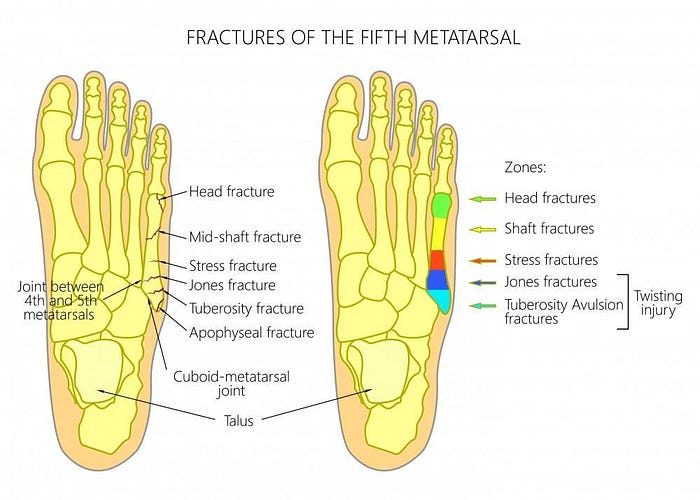5th Metatarsal Dancer’s Fracture [Recovery, Treatment & Surgery]
Summary
This article discusses fifth metatarsal fractures, specifically dancer’s fracture. It is one of the typical fractures that can occur in the fifth metatarsal. The article also covers the diagnosis and treatment options, including the use of casts, boots, and surgery. It provides information on the duration required for healing this kind of fractures.
Highlights
- 💡 Fifth metatarsal fractures include the Jones fracture and avulsion fracture and dancer’s fracture. It can occurs at different areas of the fifth metatarsal.
- 💡 Symptoms may include foot pain, redness, swelling, and difficulty walking.
- 💡 Diagnosis requires evaluation by a podiatrist and X-rays.
- 💡 Treatment options include casts, boots, and surgery.
- 💡 Recovery time can range from several weeks to several months, depending on the severity of the fracture and the individual’s health.

What is a dancer’s fracture
In essence, there are four types of fractures: Jones fractures, avulsion fractures, dancer’s fractures (also known as mid-shaft fractures), and head fractures. The purpose of this article is to specifically discuss dancer’s fractures (mid-shaft fractures).
The mid shaft fracture, commonly known as the dancer’s fracture, is frequently seen in dancers. Typically, it is an oblique fracture occurring in the mid shaft of the fifth metatarsal. However, it is important to note that this type of fracture can also affect individuals who are not dancers.
Diagnosis & Treatment
If you are lucky enough, it would be a hair line fracture. This is a repetitive, overuse, fracture injury. And what happens is, this could sometimes not be apparent on X-rays, but it starts to ache.
In the worst case scenario, it is possible that you could completely break it. Therefore, it is important to know how to diagnose a fifth metatarsal dancer’s fracture. Seeking immediate medical attention from your doctor is crucial. Initially, you may experience pain on the side of your foot where the break has occurred. However, it is essential to confirm the fracture through an X-ray examination.
If a fracture is confirmed, it is necessary to wear a cast or boot and avoid putting pressure on the affected area, even if surgery is not required. It is advisable to obtain a letter to excuse you from work and ensure that you immobilize the injured area as much as possible. Because it’s realistically gonna take months to heal up. Generally, we’re talking like three months potentially.
A boot is sometimes better than a cast but the problem is people take off their boots at home and at night and they can re-sprain, injure them. If it’s a terrible fracture sometimes you want the cast because you feel a million times better in a compressive dressing called an unabie with a cast over it. People’s pain dramatically drops even though it seems like a boot feels more comfortable trust me the cast with the compressive dressing people feel a lot better.
Surgery or Not ?
Unlike Jones fractures, most dancer’s fractures can be successfully treated without surgery by using a boot or cast, and they typically heal well. However, in certain cases where there is complete displacement or failure to heal, surgery may be necessary.
Based on my personal experience, the decision to accept surgery or not is really depends on your situations. Firstly, determine if there is a significant displacement. A non-displaced or minimally displaced fracture is when the bone cracks part or all the way through, but maintains it proper alignment. In this case, you may consider to take conversational treatment. However, if the fracture is displaced or unstable, surgery may be required to ensure proper healing and stability.
Secondly, if you have underlying conditions such as diabetes, then it is best to undergo surgery. To sum up, it is important to consult with an orthopedic surgeon to determine the most appropriate treatment approach for dancer’s fractures.
How long does it take to heal a dancer’s fracture?
If you’re able to offload it or do surgery properly I would say on average people feel about 50% better in six weeks, about 75% better at three months and about 95% better at six months, then about a hundred percent better at one year so it takes a long time. Everybody is always a little bit different so the younger and healthier people heal bit quicker but don’t think that this is gonna take you two weeks even people who are 18 year olds.
Lastly, wish you get well soon!
